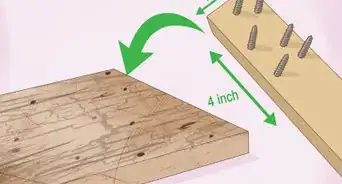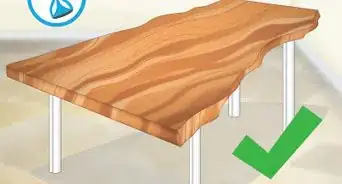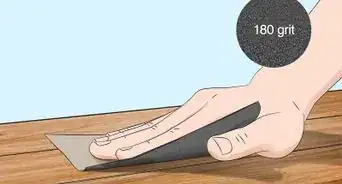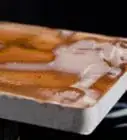This article was co-authored by Sarah Fogle. Sarah Fogle is a DIY Home Improvement Specialist and the creator of Ugly Duckling House. With over a decade of experience, Sarah specializes in beginner-friendly home remodeling projects. Sarah holds an MBA from Georgia State University. She has been featured in multiple publications including Better Homes and Gardens and Make Magazine. She has also partnered with brands such as Lowe's, Home Depot, and Martha Stewart Crafts.
wikiHow marks an article as reader-approved once it receives enough positive feedback. This article received 12 testimonials and 100% of readers who voted found it helpful, earning it our reader-approved status.
This article has been viewed 1,914,906 times.
Weathered wood can be appealing and beautiful in its own rustic way. It can be expensive, but luckily it is cheap and easy to do yourself. This wikiHow will teach you how to age wood using vinegar and steel wool to get that weathered effect.
Steps
Preparing to Make Your Stain
-
1Gather your materials. This is a fairly simple process that requires minimal supplies. You may already have them at home. If not, you should be able to find everything you need at a dollar store, grocery store, or somewhere like Target or Walmart.
- White distilled vinegar. Any brand will do.
- Steel wool. Fine graded is ideal because it disintegrates best, but any grade will work.[1]
- A container of some sort. This can be a bucket, a jar, a pot, a bowl, or whatever else you have on hand. If you dislike the smell of vinegar you may want to opt for a container you can close while the mixture sits, particularly if you want it to get quite dark, as this will involve letting it sit for a while.
- Rubber gloves. These are optional, but a good idea if you are concerned about cutting your fingers on the steel wool, or if you plan on making a particularly dark solution that might stain your fingers.
- A strainer. This is also optional, as you can apply the stain straight from whatever container you made it in. This will come in handy if you want to transfer the liquid to another container to store and use again later.
- A paintbrush.
-
2Make sure you are staining an appropriate kind of wood. Some woods will work better than others. You don’t want to go to the trouble of making a stain only to discover that it won’t stain.[2]
- Wood with bifurcated grains is best, particularly where the wood grain is layered in hard/soft layers, so the soft layers are affected by the process but the hard layers are not, causing the wood to look old.
- Softwoods are easier to work with than hardwoods. Southern yellow pine, western cedar, and fir are excellent candidates for aging. Red oak, maple, or other slow-growing, tightly grained woods are not.[3]
- Hardwoods with a distinct grain, such as hickory, white oak, elm, or ash, can also work well.[4]
- This method is not appropriate for laminate flooring, as the vinegar will likely cause the glue holding the layers together to fall apart.
Advertisement -
3Decide how you want your wood to look. Stains made with steel wool and vinegar range from a reddish, rusty brown, to a very dark, burnt brown. They also range in intensity from very subtle, to very intense. These factors are influenced by the ratio of steel wool to vinegar, and by how long you let the mixture sit. Before you begin, decide approximately color stain you want to create, and plan accordingly.
- The color of the stain is determined by how long it sits. Stain soaked for just a couple days will have a dark, burnt tone. The longer it sits, the rustier in color it will become.[5]
- The intensity of the stain is determined both by how many steel wool pads you use, and how long you let the mixture sit. 1-3 steel wool pads to a half-gallon of vinegar should work for most projects. If you want your stain to darken faster, try adding another steel wool pad. If it becomes too dark, simply dilute it with water.
Making Your Stain
-
1Break up your steel wool. This step is not strictly required, but it will help the disintegration process and speed things up. You will want to wear plastic gloves to avoid cutting your fingers. Break apart the steel wool pads, and put the pieces in the container you are mixing your stain in.
-
2Combine your materials. This is pretty straightforward. Just pour the vinegar over the steel wool. Give it a good mix, and put the cover on.[6]
-
3Let it sit. You can create a very subtle stain in just 15 minutes or so, but you will probably want to wait longer. 2-4 days will make a stain suitable for most projects, but you can let the mixture steep for months at a time to create a more dramatic effect.[7]
-
4Strain the stain. This is an optional step and is more important if you plan on storing the stain for later use. When it reaches the color you want, you can pour the mixture through a colander and into a new, sealable container. You can also use it straight from whatever container it is in.
Applying Your Stain
-
1Stain a test surface. Without knowing what your stain looks like when applied, you might not want to brush it onto your furniture just yet. Brush some onto a scrap piece of the same sort of wood, or a part of whatever you are staining that is not usually visible, and wait an hour. If you don’t like the color you end up with, make adjustments to your mixture; add more steel wool or wait longer if you want it to be darker, wait longer if you want it to be redder, or dilute it with water if you want it to be more subtle.[8]
-
2Sand the wood. Sanding your wood down before painting it can give it an even more dramatically weathered look. This step is optional, and your stain should look good with or without it. It’s just a matter of what effect you want to achieve. [9]
-
3Brush the stain onto the wood. There is no particular technique necessary for this. Brush in the direction of the grain, coating it evenly, and let it sit to allow the stain to penetrate the wood.[10] Then just let it dry, and sit back and admire your work.
-
4Wax the wood. You can choose whether or not to do this based on how you want the final product to look. For a polished sheen, wait for the wood to dry completely, brush on the wax, let it dry for an hour, and polish it with a towel. If you want a more natural, weather-beaten look, skip this step.
Community Q&A
-
QuestionDoes the wood smell like vinegar after it has dried?
 Community AnswerIt may, but you can remedy the problem by sealing the vinegar stained item with either shellac or polyurethane.
Community AnswerIt may, but you can remedy the problem by sealing the vinegar stained item with either shellac or polyurethane. -
QuestionWill it work on stained wood I haven't sealed it yet?
 Community AnswerYes, it will make any knot or grain run darker.
Community AnswerYes, it will make any knot or grain run darker. -
QuestionCan the stain be applied to painted wood, or does it have to be sanded?
 Community AnswerAs opposed to paints, most stains work by slightly penetrating the wood. You might get some effect on top of paint, but it likely won't be as dark, and may rub off easily, depending on the underlying paint.
Community AnswerAs opposed to paints, most stains work by slightly penetrating the wood. You might get some effect on top of paint, but it likely won't be as dark, and may rub off easily, depending on the underlying paint.
References
- ↑ http://www.lilblueboo.com/2014/04/how-to-antique-and-age-wood-instantly-for-a-weathered-look.html
- ↑ http://www.craftaholicsanonymous.net/how-to-age-wood-tutorial-guest-post-from-que-linda
- ↑ https://www.youtube.com/watch?v=JLQy03U2RWI
- ↑ http://www.craftaholicsanonymous.net/how-to-age-wood-tutorial-guest-post-from-que-linda
- ↑ https://www.youtube.com/watch?v=nuioNBz0mII
- ↑ https://www.youtube.com/watch?v=JLQy03U2RWI
- ↑ http://www.lilblueboo.com/2014/04/how-to-antique-and-age-wood-instantly-for-a-weathered-look.html
- ↑ http://www.thediygirl.com/aging-wood-tea-vinegar-steel-wool
- ↑ http://www.thediygirl.com/aging-wood-tea-vinegar-steel-wool
About This Article
Fill a mason jar with a steel wool sponge and white distilled vinegar and let it sit for 2-4 days. Once you’ve strained the jar, your stain is ready to use! Use a brush to evenly coat the wood. For additional advice on how to create an aged look, read on...



























































